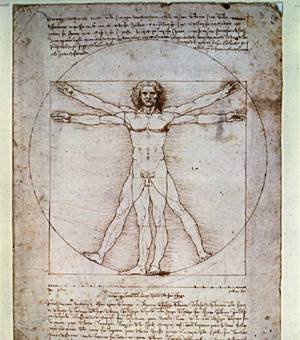Teaching Leonardo: An Integrated Approach
Editors’ Note: The history of mathematics readily lends itself to interdisciplinary teaching. Rick Faloon, a mathematics instructor at the Ross School, East Hampton, NY, joined with colleagues of other disciplines to develop a student project dealing with aspects of the Renaissance. During the April annual meeting of the NCTM held in Philadelphia, Rick gave a poster presentation on his project and its results. Below is an outline of the project together with some students’ work. For more information on this exciting strategy of using the history of mathematics in teaching, contact Rick Faloon directly at rfaloon@ross.org.

The Ross School's ninth grade integrated Leonardo notebook project was co-designed by high school art, mathematics, and science faculty. Taught in conjunction with a cultural history unit on the Renaissance, the aim of this project was to encourage students to think expansively across disciplines and perform like a Renaissance person by producing notes, drawings and mathematical calculations based on their own observations and experiences. As the notebooks demonstrate, students used Renaissance drawing methods such as crosshatching, foreshortening and perspective to create botanical drawings, drawings of inventions and mechanical objects, master copies, studies from the model, and other observational drawings. The science component involved dissecting animals and producing drawings that rendered and identified organs. In mathematics, students measured and drew geometric forms and calculated their volumes. They learned Geometer's Sketchpad and used it to analyze the perspective used in Renaissance paintings as well as to digitally produce their own perspective drawings. In addition, they made measurements of the proportions of the Vitruvian Man and were able to determine its correspondence to the Golden Mean and the Fibonacci Sequence.
Teaching Leonardo: An Integrated Approach - Introduction
Editors’ Note: The history of mathematics readily lends itself to interdisciplinary teaching. Rick Faloon, a mathematics instructor at the Ross School, East Hampton, NY, joined with colleagues of other disciplines to develop a student project dealing with aspects of the Renaissance. During the April annual meeting of the NCTM held in Philadelphia, Rick gave a poster presentation on his project and its results. Below is an outline of the project together with some students’ work. For more information on this exciting strategy of using the history of mathematics in teaching, contact Rick Faloon directly at rfaloon@ross.org.

The Ross School's ninth grade integrated Leonardo notebook project was co-designed by high school art, mathematics, and science faculty. Taught in conjunction with a cultural history unit on the Renaissance, the aim of this project was to encourage students to think expansively across disciplines and perform like a Renaissance person by producing notes, drawings and mathematical calculations based on their own observations and experiences. As the notebooks demonstrate, students used Renaissance drawing methods such as crosshatching, foreshortening and perspective to create botanical drawings, drawings of inventions and mechanical objects, master copies, studies from the model, and other observational drawings. The science component involved dissecting animals and producing drawings that rendered and identified organs. In mathematics, students measured and drew geometric forms and calculated their volumes. They learned Geometer's Sketchpad and used it to analyze the perspective used in Renaissance paintings as well as to digitally produce their own perspective drawings. In addition, they made measurements of the proportions of the Vitruvian Man and were able to determine its correspondence to the Golden Mean and the Fibonacci Sequence.
Teaching Leonardo: An Integrated Approach - Renaissance Notebook Assignment
[Here is the basic assignment given to the students:]
Over the course of this trimester each of you will create pages for a Renaissance notebook inspired by the work of Leonardo Da Vinci and by other Renaissance artists. The objective of this project is to give you an opportunity to perform like a Renaissance person by making your own observational sketches, perspective studies, mathematical calculations, scientific notes and drawings.
Your book must contain competent examples of the following:
Art
- Imagined creature drawing Blind contour drawing (palm of hand)
- Modified contour drawing (hand)
- Mechanical drawing (from boat or from mechanical objects in class)
- Leaf drawing (using contour in ink and pencil)
- Tonal drawing of torso (using chiaroscuro sfumato)
- Silverpoint drawing
- 10 quotations from Leonardo
- 10 quotes from others including the Vasari quotation (relating to Leonardo’s seven traits)
- Leonardo biography page
- List of seven traits of Leonardo with your commentary on your own traits
- Anatomy drawing from model (with muscles labeled)
- Gesture drawings of figure (using ink, conte, etc)
- Facial expression drawing
- Backwards writing
- Master copies -Michelangelo back drawing (crosshatching)
- Mantegna - Dead Christ (foreshortening)
- 3 copies of works of Leonardo or other Renaissance artists (your choice)
- Art History images/pages with notes
Mathematics
- 2 drawings of Platonic Solids using 1 or 2 point perspective. Show area and volume
- Tiled Piazza in 1 point linear perspective. Show all measurements and correct perspective. Include quotation by Pierro della Francesca
- Vitruvian Man and Golden Mean
- Fibonacci Sequence
- Mathematical evaluation of a Renaissance Painting showing horizon line, vanishing point, orthogonal lines, eye point and correct ratios demonstrating correct linear perspective.
Science
- 2 Dissection drawings (done in science class in conjunction with dissection)
- Drawing of simple machine in Leonardo style; explanation of physics of mechanism
What follows is taken from the mathematics section of this project.